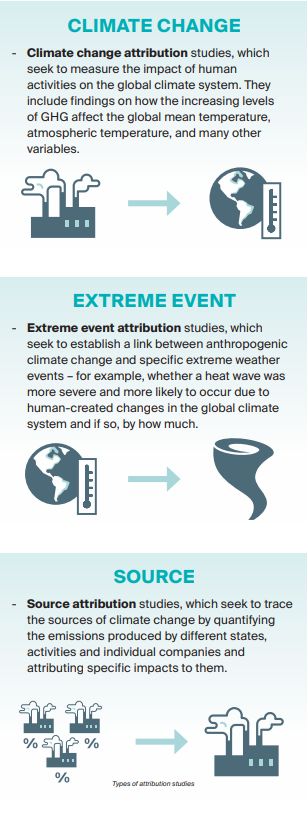- within Energy and Natural Resources topic(s)
1. INTRODUCTION
Attribution science is a relatively new field of research which seeks to establish a link between drivers of climate change – in particular rising greenhouse gas (GHG) emissions - and observed changes in climatic variables.
Plaintiffs are increasingly relying on the findings of attribution science in climate litigation against companies in order to compel them to reduce the level of GHG emissions and to establish liability for damages caused by climate change-related weather events.
In this report, we briefly explain what attribution science is and the role it may play in climate litigation, particularly in relation to the plaintiff's burden to prove (legal) causation in civil liability actions.
2. WHAT IS ATTRIBUTION SCIENCE?
The U.N. Intergovernmental Panel on Climate Change (IPCC) defines 'attribution' as "the process of evaluating the relative contributions of multiple causal factors to a change or event with an assignment of statistical confidence", where 'confidence' is, in turn, defined as "[t]he robustness of a finding based on the type, amount, quality and consistency of evidence..." (IPCC Sixth Assessment Report (2021), The Physical Science Basis, Glossary).
In other words, attribution science is a statistical exercise that examines the impact of anthropogenic (i.e. human-induced) climate change factors on human or natural systems. For example, the IPCC has found that human-induced climate change is likely the main driver of the increased frequency and intensity of heavy precipitation since 1950 (IPCC Sixth Assessment Report (2021), Summary for Policymakers, A.3.2).
Since its inception in the early 2000s, attribution science has been applied in different types of studies, including:

3. USE OF ATTRIBUTION SCIENCE IN COURT PROCEEDINGS AGAINST COMPANIES
3.1 Examples
Plaintiffs are relying on attribution science in order to hold companies accountable for the alleged consequences of their historical GHG emissions (liability actions) and to compel companies to reduce their emissions going forward (climate change mitigation actions; for an overview, see Climate Dispute Risk for (Swiss) Companies).
In Milieudefensie et al v Royal Dutch Shell, the plaintiffs relied on various climate change attribution studies and reports. For example, they used data from the IPCC's Assessment Reports, the United Nations Environmental Programme's Production Gap Report, and the University of Oxford's Protocols and Guidelines for Climate Change for Non-State Actors, to argue that Shell must reduce its GHG emissions by 45% by 2030 and to reach net zero by 2050 to meet the global climate targets of the Paris Agreement.
The Hague District Court accepted the findings of the IPCC Reports as scientific evidence for a number of factual proposition as well as for possible reduction pathways that would lead to compliance with the Paris Agreement. It held in particular that:
- "the goals of the Paris Agreement [as derived from the IPCC reports] represent the best available scientific findings in climate science, which is supported by widespread international consensus";
- "the court assumes that it is generally accepted that global warming must be kept well below 2ºC in 2100, and that a temperature rise of under 1.5ºC should be strived for";
- "there is a widely endorsed consensus that in order to limit global warming to 1.5°C, reduction pathways that reduce CO2 emissions by net 45% in 2030, relative to 2010 levels, and by net 100% in 2050, should be chosen".
In a case currently pending before the German courts, Luciano Lliuya v. RWE AG, a Peruvian farmer is seeking damages from German energy producer RWE, for costs incurred setting up flood defenses to protect his land from the threat of a melting glacier. The plaintiff seeks compensation of 0.47% of the total costs for him to set-up flood defenses which he claims corresponds to RWE's share in global greenhouse gas emissions. At the core of his claim is a source attribution research from 2014 which sought – for the first time - to quantify the cumulative global CO2 and methane emissions discharged since the industrial revolution and trace them back to the 90 largest producers of crude oil, natural gas, coal, and cement ("largest" being defined as companies emitting 8 million tonnes of carbon or more in "a recent year"). The author of the research estimates that RWE is responsible for 0.47% of the historical global GHG emissions on the basis of the company's publicly available data from 1965 to 2010.
Another example relates to proceedings in the Philippines at the initiative of Greenpeace Southeast Asia and Others, who applied to the Commission on Human Rights of the Philippines (CHRP) to investigate the major fossil fuel companies for the alleged violation of human rights of Filipinos by causing climate change and ocean acidification. In its final report of June 2022 (CHRP Report), the CHRP accepted the IPCC Reports and other attribution science research as scientific evidence for a number of climate change- related propositions, including that the 50 major fossil fuel companies contributed to 21.4% of the global greenhouse gas emissions. However, the CHRP also cautioned that "there is a distinction between the science of event attribution and the establishment of legal causation". The CHRP thus recommended the elaboration of special rules of evidence for attributing climate change impact and assessing damages to avoid "more climate injustice" as a consequence of the application of "stringent standards of legal causation"
In Switzerland, the first publicly known case against a corporation was filed very recently against Swiss cement producer Holcim. The plaintiffs in these proceedings, four inhabitants of an Indonesian island supported by three NGOs, claim that Holcim is responsible for 0.42% of the global greenhouse gas emissions. They are relying on publicly available data from 1950-2021, following a similar methodology as the study estimating RWE's emissions (by the same author). Relying on this study, the plaintiffs are reportedly demanding compensation for climate change-related damages already caused to the island, a reduction of CO2 emissions by 43% by 2030 and 69% by 2040, and a financial contribution to implement mitigation measures on the island.
3.2 Limitations of attribution science in legal proceedings
As highlighted by the CHRP in the Philippines, there is a distinction to be drawn between scientific attribution/ causation and legal causation.
In order to establish legal causation, plaintiffs must demonstrate that an act of the defendant caused the loss for which they are claiming damages or another remedy. In many jurisdictions, this is primarily done by applying:
- a counterfactual or 'but for' test and/or
- tests involving normative considerations (such as foreseeability or 'adequacy').
The standard of proof required to establish legal causation may vary considerably between jurisdictions, with some adopting a 'balance of probabilities' standard, while others require a 'near certainty' standard.
Attribution science seeks to establish risks and probabilities and to determine whether a specific element (such as CO2 emissions) contributed or is likely to contribute to an event.
Even if the causal link between greenhouse gas emissions and climate change (i.e. climate change attribution) is increasingly accepted as scientific fact, the same cannot be said for other areas of attribution science.
Plaintiffs must therefore still persuade the court:
- that (and to what extent) the defendants' emissions contributed to climate change, and
- that (and to what extent) climate change caused a specific event (e.g. a hurricane, flood, etc.).
Source attribution and extreme event attribution seek to address these two elements. However, scientific studies on these topics rarely encompass the full causal chain ('end-to-end attribution') and are often question-dependent, meaning that results can be heavily influenced by the choice of event definition and different methodologies may produce differing results, despite being equally valid from a scientific point of view. Aside from the fact that it will be difficult for plaintiffs to meet a 'but for' test of causation (in jurisdictions where this is required), defendants may deny or diminish their liability by highlighting the role of natural variability or other causal factors, and by challenging the foreseeability of the losses for which damages are being claimed.
The quality of the scientific evidence relied on by plaintiffs is also an issue. Studies are often not peer-reviewed, nor are they conducted with a view to the specific situation being dealt with in the legal proceedings. Defendants can therefore question the relevance and reliability of the underlying data, assumptions, climate models and methods applied.
4. CONCLUSION
Courts are already showing a willingness to accept the findings of climate change attribution as evidence and attribution science looks set to become an increasingly central feature of climate change litigation against companies in the future. Due to the current limitations of attribution analysis, especially with respect to source attribution and extreme event attribution reports and studies in that area likely do not meet the required standard of evidence under various national laws.
However, as more data is gathered and scientific methods perfected, attribution science is likely to become more definitive and may in time be deemed a sufficient basis to establish causation and civil liability of companies.
Originally published 18.04.2023
The content of this article is intended to provide a general guide to the subject matter. Specialist advice should be sought about your specific circumstances.
[View Source]





